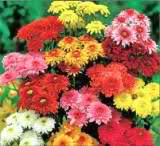 Belonging to the family Compositae, chrysanthemum or mums, for short are those delicate and enchanting flowers popular in white and pastel shades of pink and yellow.
Belonging to the family Compositae, chrysanthemum or mums, for short are those delicate and enchanting flowers popular in white and pastel shades of pink and yellow.
Chrysanthemums (Chrysanthemum morifolium) are short-day plants which grow well in areas with low temperature such as Baguio and Benguet. Chrysanthemums may be sold individually or in clusters. Potted mums (contain three-four month old flowering plants) cost P15.00 to P25.00 per pot depending on the quality and variety.
Based on cropping methods, the flowers are classified as standards, disbuds and sprays. Standards are grown with one to three stems per plant with one large flower per stem. Standard crop is characterized by a long stem. Disbuds have three or more stems with one flower per stem. To improve the size as well as the stem length, small and medium-sized cultivars are disbudded. Sprays on the other hand, are made to produce many laterals to develop and bear flowers. This is common among the singles, semi-doubles, pompons, anemones and decorative.
Propagation. Chrysanthemum can be propagated by cuttings, division, seeds and grafting. Tip cutting taken from disease-free stocks plants are the ones usually used because they propagated rapidly. The plants should be rooted in loose and friable rooting medium before they are transplanted. Stock plants should be planted in well-lighten greenhouse with a temperature maintained at 12 to 15oC.
See to it that medium is fertile, easily drained, water- retentive, well-aerated and free from pathogens. You can use sand, vermiculite, perlite, coconut coir dust, or a combination of these as rooting media. Rooting of cutting may take 15 to 21 days before they are for transplanting, depending on the variety. Cutting are ready for transplanting when the roots are about one inch long.
Cuttings can be obtained every two to three weeks. stock plants are usually discarded after three batches of cuttings because as they age, they become prone to budding and less uniform vegetative growth.
Culture management. Choose soil with good drainage and aeration. To prevent weeds and fungal problems sterilize soil for glasshouse and outdoor culture. The recommended soil pH is 6.0 to 6.5.
Plant rooted cuttings directly into raised beds or suitable containers. A one-meter wide bed uses a spacing of 15 x 20 cm (1.0 x 15 cm if single stem).
While young, the plants needs less water. As the number of leaves increases, they will need more water. However, when the flowering stage approaches water requirement decreases.
During the vegetative-growth stage, chrysanthemum uses large quantities of nitrogen and fertilizer. The following fertilizer solutions can be applied at each watering at two to three weeks intervals until flower buds show color: 200 ppm of nitrogen (about 0.45 g urea/l of water) and 200 ppm potassium (about 0.4 g muriate of potash per liter of water). Applying nitrogen fertilizer during the first 7 to 8 weeks improves flower quality.
To keep the mums erect, tie them to bamboo stakes. This will hold the flowers and the main stem of the flowers. Install the stakes on the north side to keep them from obstruction of the sunlight. Shading to minimize sunburn damage delays flower bud initiation and flower bud development. Under long days, the apex of the plant’s stem remains vegetative while under short days, flower bud differentiation occurs. After pinching, most varieties requires a period of growth (about 10 to 15 days) before they become responsive to day length for flower bud initiation.
Both flower initiation and flower development are very sensitive to temperature. To obtain better quality flowers, the temperature is usually reduced at the rate of 2oC per week until 12oC reached after the flowers become visible.
Temperature affects flower color. Under high temperature or low light intensity, bronze, pink and red cultivars become lighter in color. Temperature less than 16oC generally increases the intensity of most colors except yellow and white which become pink under cool temperatures.
Pests and diseases. Chrysanthemum is attacked by the pest like aphids, mites, thrips and leaf miners. Following the recommended dosage, they can be controlled using Phosdrin, Gusathion, Kelthane, Malathion, O-mite, Metasystox, and Sumacidin.
Chrysanthemum rust, Cercospora leafspot, Fusarium stem rot and powdery mildew are the diseases infesting the crop. Fungicides such as Dithane M45, Maneb, Daconil, Difolatan and Delsin MX can be used to control them.
Harvesting. The flowers can be harvested if they are nearly fully opened. In general, spray types are cut when the central flower is open and the surrounding flowers have developed. Cut the standards before the center florets are fully expanded. Make a cut at the soft part of the stem since very hard woody tissue may not absorb into hard stems. slightly crush the end of the stem. Remove the lower leaves to prevent them from fouling the water or holding the solution. Cut the flowers while the entire budding stage if you wish to open them artificially.
Mum cut flowers can be harvested from 2-1/2 to 6 months, depending on the variety. Flowers must be cut at the proper stage to obtained the longest vase life. Standard mums are usually cut during the 75 per cent flower-opening stage (before the green color in the flower center disappear). Harvest the flowers at the 50 per cent flowering -opening stage if they brought to distant markets.
Harvest the flowers late in the afternoon or early in the morning and remove the lower leaves. Immediately after cutting, put them in water at 5oC. You can extend their post harvest life by storing them in dry storage at 0 to 1oC for three weeks. Once they are brought out of storage, condition them by soaking their stem in a warm water at about 37 to 42oC to facilitate rapid dehydration.
Source: http://dost.gov.ph/
Photo: theflowerexpert.com
Do you like this business idea? then please consider subscribing to our PINOY BISNIS ![]() RSS feed. You can also subscribe by email and have new articles sent directly to your inbox. (Once you entered your e-mail address, you need to login to your e-mail account and click the link to confirm your subscription).
RSS feed. You can also subscribe by email and have new articles sent directly to your inbox. (Once you entered your e-mail address, you need to login to your e-mail account and click the link to confirm your subscription).




I am interested to plant crysantimum flowers please help me
Hello po, ask ko lang po mamumulaklak po ba yung mums pag nasa manila area? Puro dahon lang po kasi sya 3 months na po wala pa din flower